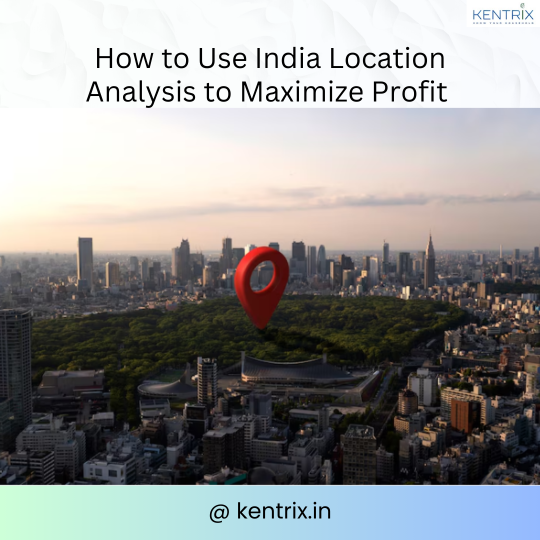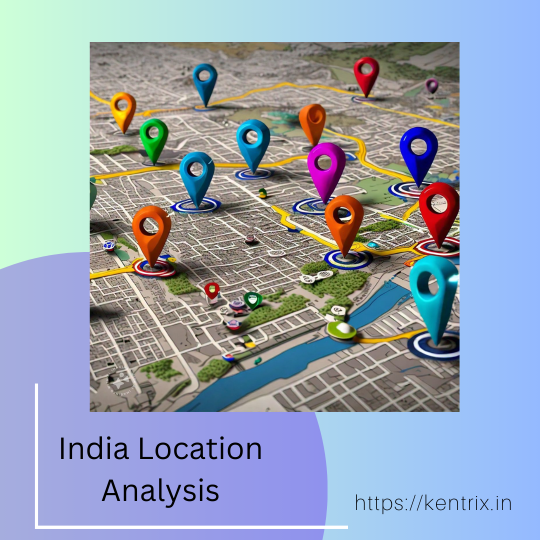In today’s fast-paced business environment, understanding where to focus your efforts can be the difference between success and failure. Location analysis is a powerful tool that helps businesses identify the most profitable regions to target. When it comes to India, with its vast and diverse landscape, the importance of location analysis cannot be overstated. By leveraging this tool effectively, businesses can maximize their profits by tailoring their strategies to the unique characteristics of different regions within the country.

Understanding India’s Diverse Geography
India’s Regions and Their Economic Significance
India is a country of contrasts, with its geography playing a significant role in its economic diversity. The country is divided into several regions, each with its unique economic significance. The northern region, with states like Delhi, Haryana, and Punjab, is known for its industrial hubs and high-income consumers. The western region, including Maharashtra and Gujarat, is a powerhouse of commerce and industry. In contrast, the southern states like Karnataka and Tamil Nadu are IT and technology hubs. Understanding these regional distinctions is crucial for any business looking to penetrate the Indian market effectively.
Key Factors to Consider in Location Analysis
Demographics: Population Density and Age Distribution
One of the first steps in location analysis is understanding the demographics of the target region. India’s population is not only vast but also diverse in terms of age distribution and density. For instance, urban areas like Mumbai and Delhi have a younger demographic with higher disposable incomes, making them ideal for products targeting young professionals. On the other hand, rural areas may have a larger proportion of older populations, influencing the type of products and services that are in demand.
Income Levels and Spending Power
Income levels vary significantly across different regions in India, directly impacting spending power. Metropolitan cities tend to have higher average incomes, allowing for a broader range of premium products and services. In contrast, rural areas, while offering larger markets, may require more affordable and basic product offerings. Tailoring your business strategy to these income disparities is essential for maximizing profit.
Cultural and Regional Preferences
India’s cultural diversity is one of its defining characteristics. Regional preferences can heavily influence consumer behavior. For example, the preference for vegetarian products is more pronounced in northern and western India, while southern regions may favor products with specific religious or cultural significance. Understanding these preferences allows businesses to customize their offerings, ensuring they resonate with the local population.
Tools and Techniques for Location Analysis
GIS (Geographic Information Systems)
GIS technology is a game-changer for businesses conducting location analysis. By mapping out various data points, such as customer locations, competitor presence, and transportation networks, businesses can visually identify the most lucrative areas to target. In India, where infrastructure and accessibility can vary greatly, GIS helps in making informed decisions about where to set up shop or how to optimize supply chains.
Also Read : Customer Data Solutions: Unlocking the Power of Information for Business Growth
Data Analytics
The use of data analytics and big data has revolutionized location analysis. For example, analyzing consumer spending habits across different regions can reveal opportunities to introduce new products or services. In India, where data is increasingly available but often fragmented, leveraging big data can provide a competitive edge.
Market Research and Surveys
Traditional market research and surveys remain valuable tools for location analysis. Conducting surveys and focus groups in different regions of India can provide insights into local consumer behavior and preferences. While digital tools offer broad data, on-the-ground research helps in understanding the nuances that are often missed in larger datasets.
Leveraging India’s Urban Markets
Major Urban Centers: Mumbai, Delhi, Bangalore, etc.
India’s major urban centers are economic powerhouses, each with its unique market dynamics. Mumbai, known as the financial capital, offers a high concentration of affluent consumers and a thriving business environment. Delhi, with its diverse population, provides a broad consumer base, while Bangalore is the tech hub, attracting younger, tech-savvy professionals. By focusing on these urban markets, businesses can tap into high-growth opportunities.
Consumer Behavior in Indian Cities
Urban consumers in India are often more brand-conscious and have higher expectations in terms of quality and service. They are also more exposed to global trends and are willing to experiment with new products. Understanding these consumer behaviors is crucial for businesses aiming to succeed in India’s competitive urban markets.
Opportunities in Tier 2 and Tier 3 Cities
While the major cities attract most of the attention, Tier 2 and Tier 3 cities in India are rapidly growing markets. These cities offer lower competition and lower operating costs while still providing access to a large consumer base. Businesses that can tailor their offerings to meet the needs of these markets stand to gain significantly.
Case Study: Successful Businesses in India Using Location Analysis
Retail Industry Examples
Retail giants in India, such as Reliance and Flipkart, have used location analysis to optimize their store locations and distribution networks. By understanding consumer demographics and spending patterns, these companies have strategically placed stores in high-potential areas while ensuring efficient supply chain operations.
FMCG (Fast-Moving Consumer Goods) Success Stories
The FMCG sector in India has been a significant beneficiary of location analysis. Companies like Hindustan Unilever have leveraged data to understand regional preferences and optimize their product offerings accordingly. This has enabled them to achieve high market penetration and customer loyalty.
Technology Startups and Location-Based Strategies
Indian technology startups are increasingly using location analysis to identify underserved markets and launch innovative products. For example, fintech companies have targeted specific regions with tailored financial solutions, leading to rapid growth and market adoption.

Challenges in Conducting Location Analysis in India
Data Availability and Quality Issues
One of the primary challenges in conducting location analysis in India is the availability and quality of data. While urban areas may have abundant data, rural regions often lack reliable information. Businesses need to invest in data collection and validation to overcome this hurdle.
Regulatory and Compliance Challenges
India’s complex regulatory environment can pose challenges for businesses conducting location analysis. Different states have varying regulations, and navigating these can be time-consuming and costly. Staying informed and working with local partners can help mitigate these challenges.
Adapting to Rapid Urbanization and Infrastructure Changes
India is undergoing rapid urbanization, leading to constant changes in infrastructure and market dynamics. Businesses need to be agile and adapt their strategies to keep pace with these changes. Regularly updating location analysis and market strategies is essential for long-term success.
Strategies to Maximize Profit Using Location Analysis
Identifying High-Growth Markets
The key to maximizing profit in India lies in identifying high-growth markets. This involves analyzing demographic trends, economic development, and consumer behavior to pinpoint regions with the most potential for growth. Businesses can then focus their efforts on these areas, ensuring a higher return on investment.
Customizing Products and Services for Local Needs
Customizing products and services to meet local needs is another critical strategy for maximizing profit. By understanding regional preferences and cultural differences, businesses can develop offerings that resonate with local consumers. This will not only increase sales but also build brand loyalty.
Optimizing Supply Chain and Distribution Networks
Efficient supply chain and distribution networks are essential for reaching consumers across India’s vast and varied landscape. By using location analysis to optimize these networks, businesses can reduce costs, improve delivery times, and ensure product availability in all targeted regions.
The Future of Location Analysis in India
The Impact of Digital India and Smart Cities
The Digital India initiative and the development of smart cities are transforming the landscape of location analysis. With increased connectivity and data availability, businesses can conduct more detailed and accurate analyses. This opens up new opportunities for targeting consumers in previously underserved areas.
Also Read : How Geospatial Analytics Can Transform Your Marketing Strategy
The Role of AI and Machine Learning in Location Analysis
AI and machine learning are revolutionizing location analysis by enabling businesses to process vast amounts of data and identify patterns that would be impossible to detect manually. These technologies allow for more precise targeting and better decision-making, leading to higher profitability.
Predictive Analytics for Future Market Trends
Predictive analytics is the next frontier in location analysis. By using historical data and current trends, businesses can forecast future market developments and adjust their strategies accordingly. This helps businesses stay ahead of the competition and take advantage of emerging opportunities.
Conclusion
Location analysis is a powerful tool that can help businesses maximize profits in the diverse and dynamic Indian market. By understanding regional differences, leveraging advanced tools and technologies, and adapting to local needs, businesses can identify high-growth opportunities and tailor their strategies for success. As India continues to evolve, those who invest in thorough and accurate location analysis will be best positioned to thrive.


